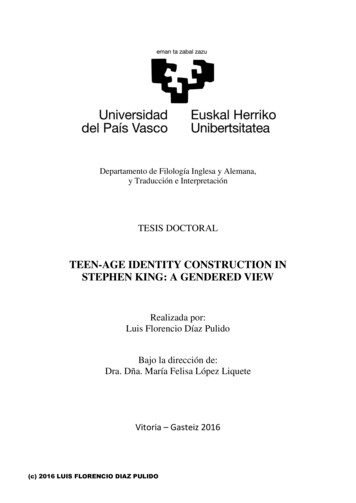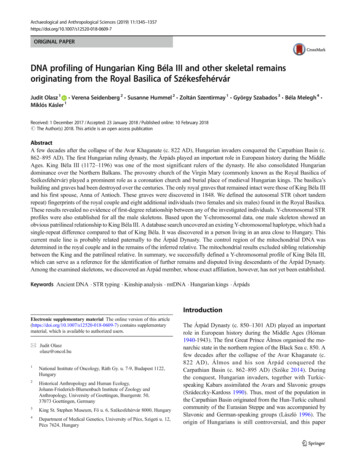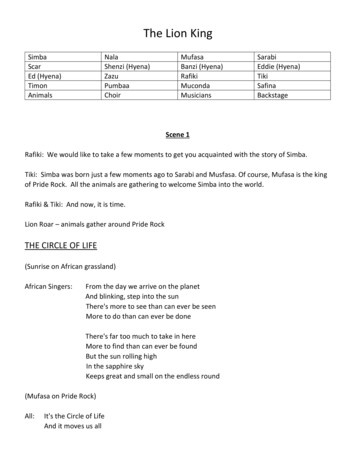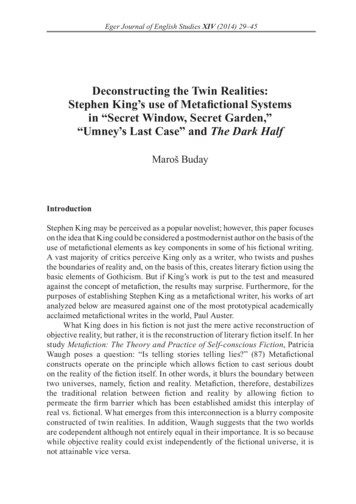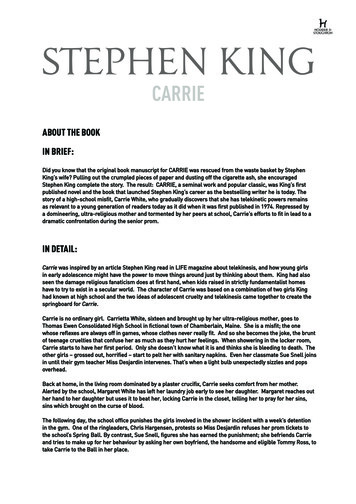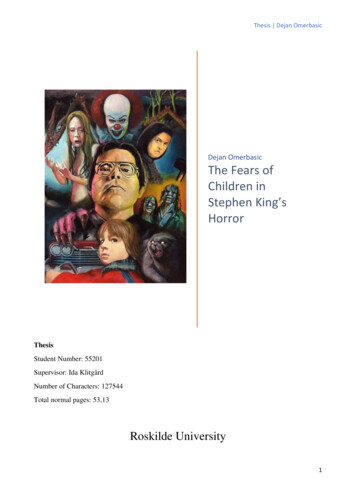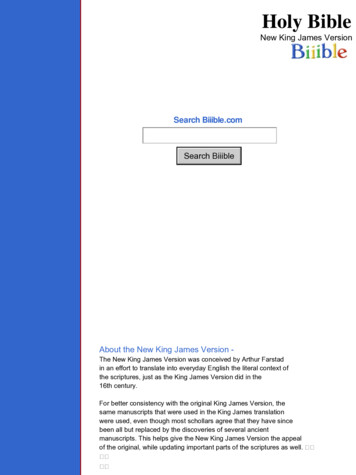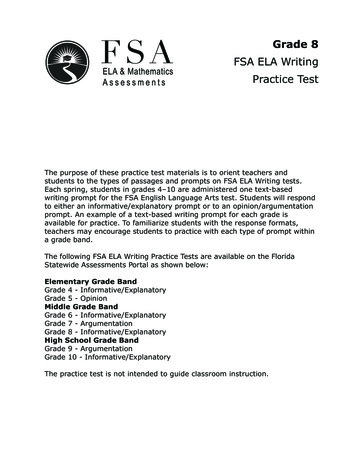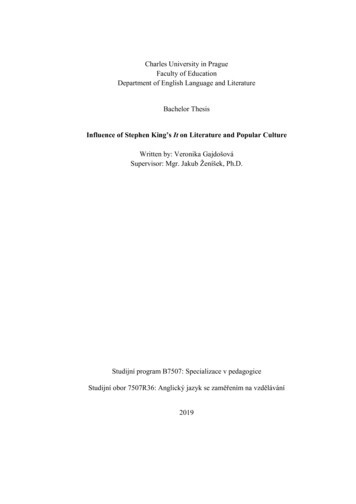
Transcription
Charles University in PragueFaculty of EducationDepartment of English Language and LiteratureBachelor ThesisInfluence of Stephen King’s It on Literature and Popular CultureWritten by: Veronika GajdošováSupervisor: Mgr. Jakub Ženíšek, Ph.D.Studijní program B7507: Specializace v pedagogiceStudijní obor 7507R36: Anglický jazyk se zaměřením na vzdělávání2019
I hereby declare that this thesis is my original work, which I have created myself. Allthe literature I used is properly quoted and is listed in Works Cited.In Prague .Signature .
AbstractThis bachelor’s thesis intends to search for the extend of influence of StephenKing’s work It on current popular culture (which includes film industry, music industry,Halloween costumes and other) and literature (demonstrated on topical examples). Thetheoretical part focuses on the life and work of the author and briefly goes over thesynopsis of the novel It. The practical part deals with examples of influence of the bookon mentioned aspects of culture (literature and popular culture). During my research Iused several sources, first of all literary works, then internet articles and online videos.Key words: literature, horror, culture, pop-culture, filmAbstraktTato bakalářská práce má za cíl prozkoumat rozsah vlivu díla To od StephenaKinga na populární kulturu (a to včetně filmového průmyslu, hudebního průmyslu,kostýmy na Halloween a dalších) a literaturu (předvedeno na konkrétních příkladech).Teoretická část se zaměřuje na život a dílo autora a stručně shrnuje knihu To. Vpraktické části se zabývám příklady vlivu knihy na zmíněné aspekty kultury (literatura apopulární kultura). K bádání jsem použila několik zdrojů, zaprvé literární díla, potéinternetové články a videa.Klíčová slova: literatura, horor, kultura, pop-kultura, film
INDEXIntroductionI. THEORETICAL PART1. Stephen King: Life and Work1.1. Personal Life1.2. Literary Works2. It – the Basic Synopsis2.1. About the Book2.2. Plot and Themes of the Book2.3. Who or What is ‘It’2.4. Lay Reception of the Book2.5. Scholarly Reception of the BookII. PRACTICAL PART3. King’s It and its Cultural Influence3.1. King’s Novel and its Literary Impact3.1.1. The Chalk Man3.1.2. Summer of Night3.1.3. Meddling Kids3.1.4. The Boys of Summer3.1.5. Conclusion of the Literary Part3.2. King s Novel and its Impact on Popular Culture3.2.1. Acknowledged Source of Inspiration and Direct Influence3.2.1.1.Movie Adaptations3.2.1.2.Film Industry and Television – Inspirations, Homages andParodies3.2.1.3.Music Industry3.2.1.4.Halloween Costumes3.2.1.5.Real-life Clowns3.2.2. Speculative Influence3.2.2.1.Film Industry
3.2.2.2.ConclusionWorks CitedAppendices2016 Clown Sightings
IntroductionMy bachelor’s thesis aims to examine aspects in which Stephen King’s famoushorror work It (1986) influenced literature and popular culture. At first, we will brieflycharacterize the author, his literary endeavors and accomplishments in the realm ofpopular fiction. Then we will briefly summarize the book and provide some basicinformation about it. After that the analytical part will be looking closer at certain piecesof literary works and analyzing the extent of the original book’s influence. Lastly, thethesis will explore some aspects of popular culture such as film or music industry andwill focus on how the book either impacted it or possibly influenced it. Last part of thisthesis is a short conclusion.Stephen King has always been remarkable author to me, considering not only thevolume of his works, but also the high quality he managed to keep each time. After Iread his novels such as Carrie (1974), Pet Sematary (1983), Cujo (1981), and of course,It (1986) I have to say I genuinely relish his stories and his use of language unlike anyother author - no wonder many of his works became instant best-sellers. After I saw themovie adaptation of It in 2017 and subsequently revisited the work after five years, itnaturally suggested itself as a topic for my bachelor thesis. Stephen King is generallyperceived as a writer of popular fiction, yet it can be argued that the inclusivity of thepostmodern canon has exonerated his literary legacy.Over the years I have seen many of his movie adaptations, often times peoplearound me were not even aware that these are based on his works, for example TheGreen Mile (1996), Shawshank Redemption (1982) or The Shinning (1977). While Ipersonally always relished his books, I feel that in European culture he is still anundervalued author. Perhaps because is an American, he enjoys more recognition in theUnited States. However, I believe the year 2019 will be a successful one for StephenKing’s career once again, since two major picture movies based on his books arecoming out – Pet Sematary1 and It: Chapter Two2.12In Czech Republic under the name Řbitov zviřátek, comes out on 14th of AprilIn Czech Republic under the name To Kapitola 2, comes out on 5th of September
It is a horror story that scared millions of readers and created the craze for clownsin horror books, movies and other media. It was enjoyable to refresh this gloomy book,especially because King always makes the story multilayered, in the sense that it infusesgothic fiction with occasional humor. If we take into consideration the fact that the UStradition of gothic fiction tends to be rather austere, these comedic elements can be seenas a variation on the postmodern conflation of tragedy and comedy. While one canassume that the horror writer only writes sad endings, it is hardly ever that King endsthe book on bad note and rather always resolves the situation in a positive manner.Horror can be perceived as very underappreciated genre, because many people(both scholars and lay readers) discredit it for its supposedly unrealistic stories. This isanother reason why I decided to focus on this particular book. While genres like thrillerand crime fiction have many readers and have come quite close to being consideredserious genres, horror is often overlooked in this respect. Just like other genres – manyhorror books are of poor quality; however, I do not think it undermines the good works,such as the one this thesis is about. While many works are only skin deep, several otherhave layers and are not just reading for bored teenager. Horror stories often times touchon real-life issues through hyperbole. People channel their real fears through fantasticstories. One such case is Godzilla – the Japanese monster that appeared in movie of thesame name in 1954. This enormous predator dooming all of humanity was widelyunderstood as an expression of fear from the tension between the U.S. and Japaneseduring the 1950s. Another example is the rise in popularity of zombie-oriented moviesand TV shows at the beginning of 21st century, which may have stemmed from the fearof terrorism (such as the one during the 11. September 2001) and the failure ofgovernment. As actress who starred in another King’s adaptation Gerald’s Game(produced by Netflix) put it: “ the horror genre is a way to allow us to talk about alot of very real things in a heightened way.” (“Your ‘Haunting of Hill House’ QuestionsAnswered by Carla Gugino.”)
I. THEORETICAL PART1. Stephen King: Life and Work1.1. Personal LifeThis section of the thesis goes briefly over the author’s life. It relies overwhelminglyon three biographical sources: On Writing, Memoir of a Craft (by Stephen King),Haunted Heart: The Life and Times of Stephen King (by Lisa Rogak) and StephenKing’s official website StephenKing.com.Stephen Edwin King was born in Portland, Maine in 1947. His parents separated earlyon in his life and he was raised by his mother, Nellie Ruth Pillsbury King. After highschool he joined the University of Maine. As a student he was fairly active, writing acolumn for the university newspaper (The Maine Campus) and also taking part instudent politics as member of the Student Parliament. He graduated in 1970 withbachelor’s degree in English. During his studies he met Tabitha Jane King (née TabithaJane Spruce) and they got married in 1971 and are together to this day. Tabitha is also awriter and an activist. They have three children together, Naomi King (born 1970),Joseph Hillstrom King (born 1972, better known as Joe Hill, which is his pen name) andOwen Phillip King (born 1977). During the first months of their marriage, King wasunable to find a job as a teacher and therefore worked as labourer in industrial laundry,occasionally selling stories for men’s magazines. In 1971 King started working as anEnglish teacher in high school in Hampden, Maine. In his spare time, he continuedwriting and working on his novels. In spring of 1973 his novel Carrie was accepted forpublishing and from then on, he was able to leave teaching a pursue career as writerfull-time. This first novel predicted more incoming successful books, because in thesame year he wrote Salem’s Lot. Sadly, around this time King’s mother passed away. In1974 the Kings temporarily moved to Colorado where King wrote another novel, TheShining (which is set in Colorado). This book was deemed so scary by the readers to thepoint where some schools removed it from its libraries. This book brought King his firstconsiderable literary success, and the publishers subsequently compelled King to write
more and more books. In 1980, the movie adaptation The Shining (directed by StanleyKubrick) came out and it was a huge success. King seemed disappointed by the film’saccuracy, particularly with respect to the main character (in the movie portrayed by JackNicholson) whom he saw as a crucial ingredient of the story. King objected that “[ ] Inthe book, he’s a guy who’s struggling with his sanity and finally loses it. To me, that’s atragedy. In the movie, there’s no tragedy because there’s no real change.” (“StephenKing on What Hollywood Owes Authors When Their Books become Films: Q&A”)If we become more irreverent with author (and American literature in general),we may claim King s affinity to alcohol is yet another thing that places him within theAmerican gothic tradition. However, with more success and therefore more stress hejust one day realized that he may like more than a healthy dose of it. As he states in thebook On Writing “‘Oh my God I am an alcoholic!’ I thought to myself and in my head,there wasn’t a single thought that would refuse this verdict” (King 74). At first, heexcused his bad habit by telling himself that it is normal for writers to drink. He kept uphis writing process despite spending the nights barely functioning. Then, in 1985, thewriter tried cocaine and also became addicted. As King states “I forgot how to be clean,because I was so ashamed” (On Writing 75). His family helped him through these lowpoints of his life and eventually, in early 90’s he got over his addiction, still taking a tollon his health later on in life. He remembers this time as one of the darkest ones in hislife. This incident did not interfere with his career and the public suspected nothing. Itwas only later (in his book On Writing) that the writer admitted this ever happened.During this time when he was going through this immense struggle, he started towork on the novel It. “[ ] I knew it will be long, but I had no idea how long.” saysKing (Rogak 184). When he finished it, he showed the manuscript to author MichaelCollings, who previously wrote biographical books about King. “He [King] told me thatIt is his life-work [ ] and that it will be the last book about monsters he will everwrite.” says Collings (Rogak 287). As we now know, there were many more such booksto come (which might be due to the readers’ demand). However, it could be speculatedthat It is his best work. Whether or not the concealed addiction had any effect on thebook – positive or otherwise – is up to a debate.
In 1987, after spending thousands of dollars on charity work, he and his wifedecided to create their own aid organisation. They created ‘Stephen and Tabitha KingFoundation’ that aimed to help students who cannot afford their college fees.The 1990s were a golden age for the King family. All their children enteredadulthood and eventually moved out. The author had enormous success in his workfield, releasing new book every year and he kept getting new and new offers on movieadaptations of his books.1999 was a big year for King. He wrote and subsequently published his bookOn Writing, where he shared a little bit about his early life (such as his tough childhood,but also his addiction problem) and tips and tricks on how to be a good writer.However, in June, he was hit by a van and nearly died. He had multiple fractures,concussion and a pierced lung. After surviving the accident, he had to rehabilitate formany following years.During the early 2000s King said multiple times that he wanted to end his careerand retire, but those claims always remained unfulfilled. The beginning of the centurywas peaceful for King and his family. His children started their careers, most of themdabbed in writing like their parents. In his lifetime, King won over 60 awards and wasnominated over 70 times.Today King lives in downtown Bangor (Maine) with his wife in a mansion that isoften visited by his fans. He is still active with his writing and publishes new booksregularly (his latest book called The Institute is coming out in September 2019).1.2. Literary WorksKing wrote over 200 titles and his books sold over 350 million copies. He is awriter with the highest amount of movie adaptations to his name. He is known as the“master of the horror”, but apart from this genre he also writes fantasy, science fiction,thrillers and crime fiction. Usually, his book does not simply follow one genre but dipsin others as well – occasional humour and romance.
He enhanced the horror genre and created his own idiosyncratic style which caneven be regarded as seminal due to several aspects: He is a very prolific author who creates new literary works regularly andpublishes them every year. He tries to create his works in a realistic manner, such as basing his stories inreal cities or using real brands of products, which subsequently makes themeasier to imagine for the reader. King does rely on visual description - only when it is necessary for the scene orplot - which places the visual aspect of the characters into reader’s hands. AsKing states: “For me, visual form of the character doesn’t exist. If I’m in thecharacter I can’t see myself.” says King (Rogak 288). In his works On Writinghe further comments: “[ ] if I wanted to read a garment description I couldalways buy a J. Crew catalogue3.” (King 137) – meaning he considers clothesdescription unnecessary, which is very apparent in It, where he only states whatthe person is wearing if it bears any significance to the story. He avoids long descriptions and prefers only brief ones and rather focuses onstorytelling and building the tension. For example shortening the sentences orword repetition is very common in his works. He strives to create his characters as good-natured people. In his words, thismakes the reader emotionally invest in the book and have therefore strongerresponse if the character encounters possibly lethal situation. As King states:“[ ]to me it’s all about characters. If you like the characters, you care and thenthe scares generally work one of the things that I wanted to do in all of mynovels is to create characters who are fundamentally decent by large and thatway you[ ] don’t want them to wipe out, you want them to live and you wantthem to win.” (“Stephen King Talks about the New IT Movie.”). King includes sexual scenes in his books and in many of his works we can findthe characters in intimate moments. He makes his characters regular people withneeds and desires, which makes them often appear more realistic.3J. Crew is an American apparel company
The author focuses on the psychology of the characters, this is either via writingtheir thoughts (which are put in cursive in order to be distinguishable fromregular plot) or by including the character’s viewpoint into the storytelling. King does not follow literary trends and tries to create stories with originalcontent. For example, when his book Gerald’s Game (this literary work featuresan adult woman who is cuffed to bed and unable to escape) was published in1992, many critics called him “exemplary feminist” (Rogak 271) and fansrepeatedly chastised the author and criticised the book for showing the femaleside of sexuality. “Loyal readers who enjoyed King’s stories about murders,massacres, supernatural monsters [ ] threw away this book with disgust whenthey found out that it’s about two lovers [ ]” (see above).In the book On Writing, he states that there are three fundamental parts of a‘good’ story:1) dialogue that “through conversation makes the characters real” – therefore attentionto direct and indirect speech;2) description “that creates sensory realism” – as mentioned, his character description isbrief and thus does not take the reader out of the story;3) and storyline “that takes story from point A to point B, and from B to Z” (all 128).And he concludes this by declaring that plot itself is not the key element, because “justlike in real life - there isn’t a plot” (King 128) implying that not everything needs to belined up. I drew these observations about his literary works from his book On Writingand his official website StephenKing.com.2. It – Basic Synopsis2.1. About the BookThis book came out in 1986, but the author worked on it for several months, andduring this time he was already well-known name not only in horror genre but inliterature in general, especially in Europe and the U.S.
When it comes to genre of the book, it is considered both psychological horrorand a coming-of-age thriller. Today this is not viewed as a novelty, however, in 1980s,this story was out of the ordinary. This literary work sparked completely new way ofwriting horror because it had several remarkable features:1) The story is very long and complex, focuses on many characters at once, whilein general, horror stories focus on one individual or one family.2) The plot has nonlinear narrative and shifts in time, which means the reader hasto pay close attention to the timeline of the story.3) There are multiple lead characters, all which are children. Otherwise, his usualapproach is one main character, typically an adult and a few side characters.This also means a considerable amount of explicit violence that happens in thestory involves children, which is something horror authors generally avoided.4) It introduced clown as a horror character. Before this novel, clowns were seen asnon-threatening, which changed afterwards.This work is also his longest – anywhere from one thousand to one thousand andtwo hundred pages. This is not a common trait amongst King’s novels, since most of hisworks are comprised of two hundred to four hundred pages. He dedicated this book tohis wife Naomi Rachel King and his two children - Owen Phillip King and JosephHillstrom King, which he mentions at the beginning of the book. Similarly, he dedicatedmost of his books to his family as well, with the dedication being written in the secondor third page.The book is written in a 3rd person narrative and the narrator is omniscient andthus reliable. King uses easily understandable language and often prefers colloquialEnglish. He never uses nonsensical words. All his locations are either real (meaningactual towns, streets etc.) or based on real life examples. The book contains aconsiderable amount of dialogue, both through direct and indirect speech. Everycharacter uses different language, the children use simpler English, unlike the adults.One specific element of this book is the main character William who stutters,increasingly in dangerous situations, which signals to the reader that the situation istense and the characters may be suffering from some deep-seated neurosis. Somecharacters use slurs – usually those who King deems as morally depraved (criminals,bullies, etc.). The author likes to use subtle storytelling (prefers more implicit language
that relies on the readers understanding). The action is swift, and the descriptions areshort. Here are some examples of the language King uses:‘Stanley? Stanley? St — ‘She looked at the tub with its blue shower curtain bunched at the far end of thestainless steel rod and forgot how to finish her husband's name. She simplystared at the tub, her face as solemn as the face of a child on her first day atschool.(King 57)Here, in line three, is one example of King’s indirect style of language. Instead ofsaying “she forgot his name” the author expresses it in more curious manner. In forthline, he uses a simile, which is original one instead of using a cliché such as “She waswhite as a sheet.”.‘Who was it, Don?' Harold Gardener asked softly.'It was Derry,' Don Hagarty said. 'It was this town.''And what did you do then?''I ran, you dumb shit,' Hagarty said, and burst into tears. (King 38)Here is example of two contrasting languages. First and third direct speecheshere are spoken by policemen and therefore their language is formal. The second andthe last direct speech is said by a man with record of criminal activity and it is displayedby his use of profanities.Kill you!' George cried, and a mixture of doglike sounds came out of that fangedmouth: yips, yelps, howls. A kind of laughter. Bill could smell him now, couldsmell George rotting. It was a cellar-smell, squirmy, the smell of some finalmonster standing slumped and yellow-eyed in the corner, waiting to unzip somesmall boy's guts. (King 924)
Here the author paints a vivid and horrifying scene by using various techniques.The repetition of the verb ‘smell’ emphasizes how strongly the character could feel thiselement in the situation. Then he compares George to a dog – this could be in order forthe reader to easily imagine the sounds and the visuals (teeth). Second line containsalliteration (yips, yelps), this could be deliberate or coincidental - it is not clear.The book, presumably, does not contain any pictures, however, there are parts thathave special visual form. This is likely in order to make the reader more interested or toexplain how something looks without overanalysing it. One such example of this is onthe page 58 where we can see letters IT as if written with blood. (attachment 1.)2.2. Plot and Themes of the BookThe story takes place in Derry, state Maine (in fact all King’s books take place inMaine) and it follows two time periods: first one from 1957-1958, when the maincharacters are children, and second one from 1984-1985, when the main characters areadults. The town seems very average for people who are just passing by, but people wholive there know that it is much darker place than the common sight allows to admit.Many of the residents are homophobic, xenophobic or just hateful towards anyone ingeneral. Another ugly secret hides in the sewers of Derry – mystical being called ‘It’(hence the name of the book). This monster comes out every 27 years to feast onhumans and their fears. Most residents are too afraid to admit that any supernaturalphenomenon takes place there. The main plot of the book follows seven people who callthemselves ‘The Losers Club’ and encounter ‘It’ as children and eventually defeat it asadults. There are more subplots in the book about other people from Derry who saw ‘It’or were otherwise affected by it. However, neither of the movies explores these subplotsin detail. The plot is slightly chaotic since it switches between the characters as adultsand as children and includes many of the side character’s stories, that usually have noeffect on the main plot.
2.3. Who or What is ‘It’‘It’ is the main antagonist of the book. ‘It’ is a gender non-specific creature ofunknown origin, but likely very old and has the ability to shapeshift in order tomanipulate one’s mind and to cause hallucinations to whoever it chooses. This creaturefeeds on people – either children or adults - and prefers its victims in fearful state.Consequently, ‘It’ makes people scared by shapeshifting into their worst fears. For eachof the character the creature manifests differently, because King wanted to reach asmany reader’s fears as possible. This way King could draw on a variety of monsters inthe story. ‘It’ takes form of: dead loved ones, The Werewolf (from the movie I Was aTeenage Werewolf), The Mummy (from movie of the same name that came out in1932), Bruce (from the movie Jaws), Dracula (version from King’s Salem’s Lot), awitch (from the fairy tale ‘Hansel and Gretel’) and many others. Source for all of theforms of the monster can be found in the article “IT (Creature).”. However, the mostrecognizable and common appearance of ‘It’ is Pennywise, the Dancing clown. Kingbased Pennywise’s appearance on looks of three clowns – Bozo the Clown, Clarabellthe Clown and also Ronald McDonald (McDonald franchise’s mascot). The first two areclown characters on two different television shows whose popularity peaked in the1960’s in the United States. He explicitly states he based Pennywise off of them in thebook It on page 19 when It’s character Georgie describes Pennywise. Originally Kingwanted to make the character a troll, because the author was inspired by story called‘The Three Billy-Goats Gruff’ (“Three Billy Goats Gruff.”). This story is a Norwegianfairy tale and features an evil troll. Later he revisited this thought and chose a differentapproach: “I thought to myself, ‘I’ll get all of the monsters together as I possibly can;I’ll get the Vampire, I’ll get the Werewolf, and I’ll even get the Mummy.’[.]But then Ithought to myself, ‘There out to be one binding, horrible, nasty, gross, creature kind ofthing that you don’t want to see[ ]’ So I thought to myself, ‘What scares children morethan anything else in the world?’ And the answer was ‘clowns‘.” (“Stephen King TalksInspiration for Pennywise and More About It.”).
2.4. Lay Reception of the BookIn 2017 (which means sometime after the second movie adaptation) the book wasranked among 100 best-selling titles according to The Guardian (“Bestselling Books of2017: the Top 100.”). In the Czech Republic It is 44. most reader recommended bookaccording to The Book Database4 (“50 Nejvíce Doporučovaných Knih.”). If we look atthe customer reviews on Amazon.com, which is a site with most ratings to this book, ithas overwhelmingly positive score, which is five stars (by 73% of readers), second mostcommon rating was four stars (14%) and only 13% of readers gave three stars or less.This percentage is made out of 4096 readers. Czech readers rated this book similarly,because if we look at the page ČBDB5 the book has 92% rated by 1627 readers (“To.”).Therefore, it can be concluded that this book has good reception by majority of thosewho read it. According to the reader’s comments, the least liked aspect of the book is itslength and overwhelming amount of characters and most liked aspect is scariness of thescenes and the storytelling. According to Wikipedia.com the book was number onebestseller in U.S. the same year it came out (1986), listed by Publishers Weekly,however this source is not reliable since there is no access to the exact source (“It(Novel).”).It should also be noted that there was resurgence of interest in the book in 2017after the release of the movie’s adaptation. This could be supported by Stephen King’sannual earnings from June 2017 to June 2018, which nearly doubled - from 15 millionU.S. dollars to 27 million (“Annual Earnings of Stephen King from May 2010 to June2018.”). It can be expected that after the release of the second part of the adaptation, asimilar leap in earnings will happen.45Databáze knih (databazeknih.cz)Československá bibliografická databáze
2.5. It – Scholarly ReceptionIt enjoyed some critical acclaim, winning British Fantasy Award in the category‘Best Novel’ in 1987. During the same year it was also nominated for Fantasy ‘Novel ofthe year’ by Locus Awards and for ‘Novel of the year’ by World Fantasy Awards. Bothof these awards are flaunted on Stephen King’s official website (StephenKing.com).II. PRACTICAL PART3. King s It and its Cultural Influence3.1. King’s Novel and its Literary ImpactThis section will present about certain literary works, all of them novels, thatshare some similarities with It (either the themes, plot-wise or narrative-wise). There isno known author that specifically said that they based their book off of the book inquestion, so my approach is to compare the works in either of the aspects and see whatthe results suggest. This segment therefore does not aim to include complete analysis ofthe books, only pinpoints parts that are comparable with It.I chose four books written in English by current popular authors. These arenovels that fans or journalists perceive as similar to It, such as in this article “10 MustRead Authors for Stephen King Fans.” or “Popular Coming Of Age Horror Books.”,which I used as a starting point for my research.
3.1.1. The Chalk ManAuthor: J. C. TudorThis recent thriller, which became fairly popular, was published on January 2018.It shares some elements that made It a good read. Both novels are written by Englishspeaking authors and their plot takes place in small towns. The titles of the books arethe main antagonists’ names in both cases, which could be merely just similar thoughtprocess shared by the authors. Apart from these two aspects, which could be purelycoincidental, there are several parallels that make it seem as if the British author tookcertain amount of inspiration from the King’s work. On the contrary, significantlydifferent aspect is the quantity of the texts. The Chalk Man has around three hundredand fifty pages and It is over one thousand pages long. Practically this means that Kinghad much more space to make the story
1. Stephen King: Life and Work 1.1. Personal Life 1.2. Literary Works 2. It - the Basic Synopsis 2.1. About the Book 2.2. Plot and Themes of the Book 2.3. Who or What is 'It' 2.4. Lay Reception of the Book 2.5. Scholarly Reception of the Book II. PRACTICAL PART 3. King's It and its Cultural Influence 3.1. King's Novel and its Literary .
